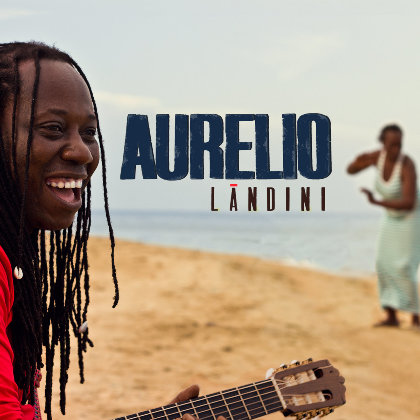- artist:Aurelio
- featured artist:Aurelio Martinez
- region:Central America
- release year:2014
- style(s):Paranda, Garifuna
- country:Honduras
- formats:Audio File / Digital
- record posted by:Stonetree Records
- label:Stonetree Records
- buy this record
Links
On the Caribbean coast of Honduras, in the tiny village of Plaplaya, Garifuna songwriter, singer, and guitarist Aurelio first learned music at his mother's knee. At the end of the day, villagers would return in their boats to the river landing, gathering to hear paranda, the guitar-driven music of Garifuna troubadours who teased and taught, bemoaned and praised community life.
His childhood village has become a touchstone for Aurelio, a dedicated Garifuna cultural advocate and musical innovator. In original songs crafted by Aurelio and his mother Maria Martinez, as well as traditional tunes, he returns to the landing place that launched him with Lándini ("landing" in Garifuna), a swaying, bittersweet homage to his beloved home and people.
I consider this album to be the sound of my Garifuna people. On the previous album [Laru Beya] we experimented and collaborated with other artists to reconnect what was lost between Africa and America. This album is purely Garifuna, and the entire spirit of the music reflects the Garifuna experience.
Though it incorporates elements from a wide variety of sources, Garifuna music's heart beats with very personal, deceptively simple tales. Aurelio credits his mother Maria, who dreamed of being a professional singer, with introducing him to the basics of Garifuna songcraft. Like many Garifuna, she composed her own songs based on community events and her personal experience. She would teach the verse and chorus of the songs to her son, who would then go on to build on the tale by adding another verse, in traditional Garifuna style.
My mother is the sole inspiration for this album, says Aurelio. My mother sees herself reflected in me, to a large degree, the only one of the family who could fulfill her dream of singing professionally. She reminds me of songs, and will give me advice on music and the songs. She's the best example I have in my life of what a human being should be, my main consultant and confidante.
Irawini ("Midnight") reflects this affectionate, collaborative bond between mother and son. Composed by Maria, it tells of listening to Aurelio play guitar in the distance, as she waits anxiously for his return home one night.
Garifuna songs, be they new or very old, are often filled with teasing humor and straightforward meditations on relationships. They chronicle major events in the life of a community; Milaguru is a plea for the captain of a ferryboat that capsized, killing all aboard, to be careful and steer his passengers home. Other songs tell of personal sorrows: the persecution and heartbreak of Durugubei Mani, which laments the singer's persecution by the community, or Nafagua, which laments the death of a loved one.
What's really important is how the listener interprets a song via his or her own experience, explains album producer Ivan Duran. When a Garifuna song becomes popular in the community, it's usually not because it has a catchy melody or it's a fun song. It's because the experience that is conveyed in the song resonates with the listeners' own experiences. Songs that resonate are re-purposed, transformed over time as singers add new names and places, new thoughts and verses.
In their stark simplicity, Garifuna songs find unexpected depth. They often carry a double meaning that embraces life's ambivalence, the gray area between love and irritation, between happiness and woe. It's a combination Garifuna troubadours have refined to streamlined perfection, pairing upbeat, dynamic rhythms with melancholy, heartfelt melodies.
In recording Lándini, Duran - who hails from Belize and has dedicated most of his professional life to working with Garifuna artists - strove to accentuate songs' double nature, with their complex emotional resonances. Duran's touches are restrained and subtle, leaving the spotlight on Aurelio and his long-time band's delicate drive and passionate performances, on the sounds of the drums, voices, and guitars masterfully played by Guayo Cedeño.



